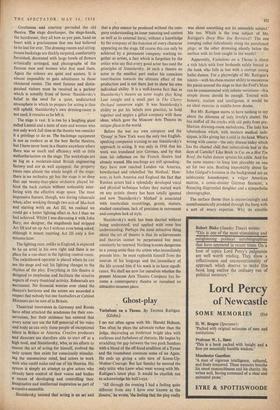Ghost-play
Variations on a Theme. By Terence Rattigan. (Globe.) I Do not often agree with Mr. Harold Hobson. Too often he plays the advocate rather than the judge, decorating an irrelevant bright idea with curlicues and furbelows of rhetoric. He begins by straddling the gap between the two posh Sundays with a blend of the off-hand erudition of a Tynan and the roustabout common sense of an Agate. He ends up giving a solo turn of Knees-Up- Mother-Courage. But last Sunday he seemed the only critic who knew what went wrong with Mr. Rattigan's latest play. It would be churlish not to acknowledge his bull's-eye.
'All through the evening I had a feeling quite different from any I have ever known in the theatre,' he wrote, 'the feeling that the play really was about something not its ostensible subject.' Me too. Which is the true subject of Mr. Rattigan's Deep Blue Sea Revisited? The one romping rather ridiculously along the pasteboard plage, or the other drowning silently below the surface with its foot caught in the weeds?
Apparently, Variations on a Theme is about a rich bitch with four husbands safely buried in the bank who falls in lust with a corrupt young ballet dancer. For a playwright of Mr. Rattigan's talents—with his chess-master ability to manceuvre his pieces around the stage so that the Fool's Mate can be consummated with infinite variations—this simple theme should be enough. Treated with honesty, realism and intelligence, it would be an ideal exercise in middle-brow drama.
But Mr. Rattigan seems to have nothing to say about the dilemma of lady lovely's chattel. He has stuffed all the cracks with old putty from pre.- Shavian drawing-room melodrama. The lady has tuberculosis which, with modern medical tech- niques, is like giving her a cold in the head. What's wrong with cancer—the only disease today which has the charnel chill that tuberculosis had in the days of Camille? Like Brick in Cat on a Hot Tin Roof, the ballet dancer sprains his ankle. And for the same reason—to keep him plausibly on one set for two acts. Bustling improbably about Sir John Gielgud's business in the background are an aristocratic housekeeper, a vulgar American matron, a comic-sinister German financier, a flouncing disgruntled daughter and a sympathetic choreographer.
The surface theme then is unconvincingly and unenthusiastically prodded through the hoop with a sort of weary expertise. Why do sizeable stretches of the play still grip and shock and embarrass as a real play should? Because the true subject should be a homosexual relationship be- tween a bored and ageing rentier and a sharp, oily male tart. As with some of Proust's women, the heroine here should have five o'clock shadow bristling through her make-up. Though Miss Mar- garet Leighton is as slender and beguiling as a Silver snake walking precariously on its tail, her role makes no sense for a woman. Jeremy Brett's cocky gigolo has an epicene ambiguity which can only come alive if his victim is a man. The final impression is rather like Lady Windermere's Fan put on by a girls' school where the producer had instructed his cast to play their parts as if all the characters really were girls.
Whether Mr. Rattigan intended us to see such a theme behind the gauze, I do not know. Certainly the present play is a relative failure. The ghost-play underneath could be a masterpiece. If Mr. Rattigan doesn't write it, somebody else should.
ALAN BRIEN



































 Previous page
Previous page